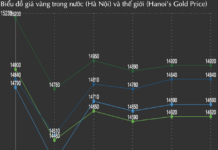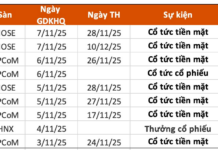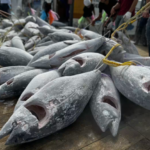It’s tuna.
Recently, the Government Office issued Document No. 8640/VPCP-NN, conveying the Prime Minister’s directive regarding the handling of reported information related to tuna exports.
The document states that the Vietnam Association of Seafood Exporters and Producers (VASEP) has indicated that tuna exports are projected to fall short of the annual target. Specifically, according to VASEP, Vietnam’s tuna exports have stagnated, with a 20% decline in revenue in July compared to the same period last year. This has brought the cumulative total for the first seven months of this year down to nearly $542 million, 3% lower than the previous year.
VASEP also noted that, starting August 7, the U.S. began applying new countervailing duties for each country. The disparity in duty rates imposed on Vietnamese products compared to competitors like Thailand, Indonesia, and Ecuador is diminishing Vietnam’s competitive edge.
Additionally, geopolitical instability, logistical challenges, and fluctuating demand in key markets such as Russia, Israel, and Chile are significantly impacting Vietnam’s export activities to these regions.
Meanwhile, tuna enterprises are grappling with numerous challenges, as regulatory bottlenecks in fishing, processing, and exporting tuna remain unresolved. VASEP predicts that Vietnamese tuna will struggle to break through and maintain its market share this year.
In response, the Prime Minister has tasked the Acting Minister of Agriculture and Environment with investigating the reported information and coordinating with relevant ministries and agencies to assess the tuna export situation in 2025. They are to promptly address difficulties and obstacles within their jurisdiction and in accordance with regulations.
On September 15, Minister of Industry and Trade Nguyen Hong Dien sent a letter to U.S. Secretary of Commerce Howard Lutnick, urging the Department of Commerce (DOC) and the National Oceanic and Atmospheric Administration (NOAA) to reconsider their decision to deny equivalency for 12 Vietnamese fishing methods. This decision could severely disrupt bilateral trade and jeopardize the livelihoods of hundreds of thousands of Vietnamese fishermen and workers.
According to VASEP, seafood caught using these methods will be banned from entering the U.S. starting January 1, 2026. This measure is tantamount to an import ban, significantly affecting Vietnam’s key seafood exports to the U.S., including tuna, swordfish, grouper, mackerel, croaker, crab, squid, and scad.
Exporters estimate that the immediate economic loss will be substantial. VASEP projects a potential annual loss of $500 million in the U.S. market, equivalent to the total export value of affected products to the U.S. in 2024, which stood at $511.5 million.
Notably, tuna, which accounted for the largest share at $387 million out of nearly $1 billion in 2024, faces the risk of being completely shut out of the U.S. market. Other critical products like crab, squid, grouper, mackerel, and swordfish will also be severely impacted.
Furthermore, the U.S. decision directly threatens the livelihoods of hundreds of thousands of fishermen and workers in processing plants.
Vietnamese Tuna Exported to Over 110 Markets

Vietnamese tuna is exported to numerous countries and territories worldwide. Photo: VASEP
Tuna is a key seafood product concentrated in Central Vietnam and the South China Sea. In recent years, tuna has consistently accounted for the largest share of total seafood export revenue, ranking third in value among Vietnam’s aquatic exports.
According to VASEP, Vietnam’s annual tuna production (including yellowfin tuna, bigeye tuna, skipjack tuna, and others) exceeds 200,000 tons. Yellowfin and bigeye tuna have an average reserve of over 45,000 tons, with annual catches ranging from 17,000 to 21,000 tons. Notably, yellowfin and bigeye tuna are harvested during a six-month period from December to June of the following year, while skipjack tuna can be caught year-round.
In 2024, Vietnam’s tuna export revenue nearly reached $1 billion, a 17% increase compared to 2023.
Over the past five years (2019–2023), Vietnam’s tuna export revenue grew from $719 million in 2019 to $845 million in 2023, with an average annual growth rate of 3%. According to VASEP, Vietnamese tuna products are now exported to over 110 global markets. The U.S., EU, Middle East, and CPTPP countries are the top four consumers, accounting for 82–86% of Vietnam’s total tuna export revenue.
The Ultimate Guide to Exploding Sales: How a Vietnamese Product Took Europe by Storm
“Vietnam has been a powerhouse in exporting these particular products over the past few years, and its dominance in this industry is remarkable.”
The Art of Adaptation: Navigating the US Tariff Landscape
As per the statement by the Minister of Industry and Trade, the US will impose a 20% countervailing duty on Vietnamese goods, effective from 12:00 PM on August 7, Washington D.C. time. This translates to the tariffs taking effect in Vietnam within a day. The Ministry of Industry and Trade has promptly submitted to the Prime Minister a task force proposal, assigning relevant ministries and sectors to effectively adapt to this new tariff policy.
Seafood Exports Surpass $10 Billion: Unveiling the 2 Star Products
The seafood industry has witnessed impressive growth in exports, inching closer to the significant milestone of $10 billion annually. This remarkable journey can be largely attributed to the stellar performance of two key players: shrimp and catfish. As the industry surges ahead, these two aquatic powerhouses have emerged as the primary contributors to its success, solidifying their status as the backbone of this thriving sector.
Seafood Exports for the First Ten Months Reached $8.3 Billion, with Key Products Showing Strong Growth
The seafood industry is swimming towards success, with October’s achievements pushing the 10-month tally to a remarkable $8.33 billion in export turnover. This impressive figure marks a 12% increase compared to the same period last year, showcasing the sector’s resilience and growth. Key products such as shrimp, pangasius, and tuna have all witnessed positive growth trajectories, contributing to the industry’s overall triumph.










































